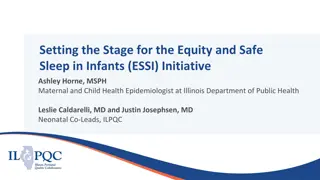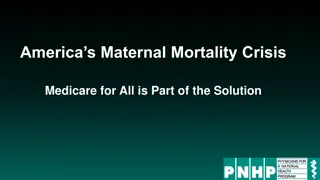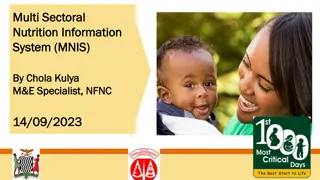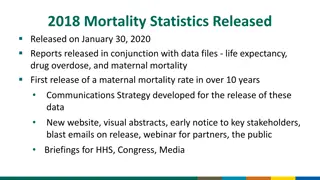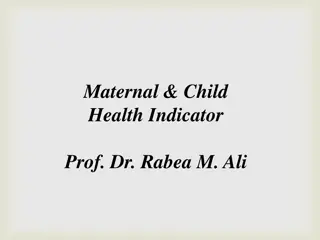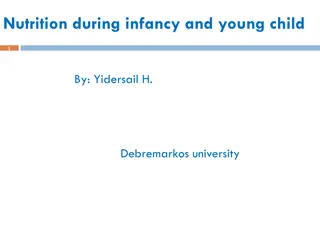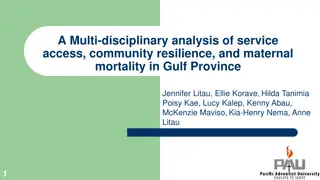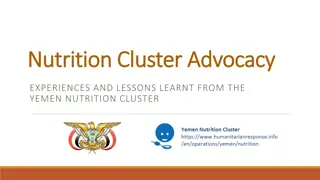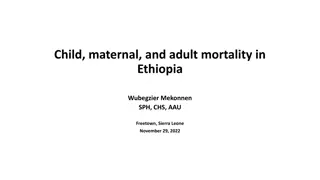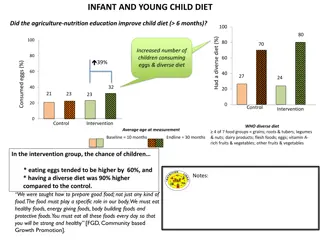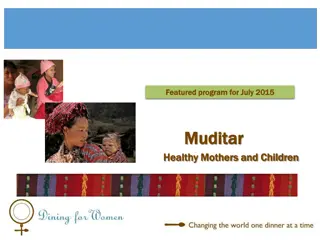Impact of Nutrition on Infant Mortality: Recommendations for National Strategy
Infant mortality reflects a society's commitment to healthcare, nutrition, housing, and environment. Public health nutritionists play a critical role in preventing infant mortality. The need for comprehensive interventions to address nutrition inadequacies and reduce infant mortality rates is emphasized in this report, alongside the importance of a sustained focus on nutrition. The data shows a decrease in the US ranking for infant mortality over the years, highlighting the ongoing challenge and the imperative for continuous efforts in this area.
Uploaded on Feb 19, 2025 | 1 Views
Download Presentation

Please find below an Image/Link to download the presentation.
The content on the website is provided AS IS for your information and personal use only. It may not be sold, licensed, or shared on other websites without obtaining consent from the author.If you encounter any issues during the download, it is possible that the publisher has removed the file from their server.
You are allowed to download the files provided on this website for personal or commercial use, subject to the condition that they are used lawfully. All files are the property of their respective owners.
The content on the website is provided AS IS for your information and personal use only. It may not be sold, licensed, or shared on other websites without obtaining consent from the author.
E N D
Presentation Transcript
A S S O C I AT I O N O F S T AT E P U B L I C H E A LT H N U T R I T I O N I S T S A S S O C I A T I O N O F S T A T E P U B L I C H E A L T H N U T R I T I O N I S T S
A S S O C I A T I O N O F S T A T E P U B L I C H E A L T H N U T R I T I O N I S T S
A S S O C I A T I O N O F S T A T E P U B L I C H E A L T H N U T R I T I O N I S T S
Summarizes the impact of nutrition on infant mortality Identifies areas where nutrition interventions can make a difference Describes the critical role that public health nutritionists play in preventing infant mortality A S S O C I A T I O N O F S T A T E P U B L I C H E A L T H N U T R I T I O N I S T S
Infant mortality is a multi-factorial phenomenon, with rates reflecting a society s commitment to the provision of high quality health care, adequate food and good nutrition, safe and stable housing, a healthy psychosocial and physical environment, and sufficient income to prevent impoverishment. Recommendations for HHS Action and Framework for a National Strategy; 2013 A S S O C I A T I O N O F S T A T E P U B L I C H E A L T H N U T R I T I O N I S T S
Is part of a complex whole of interventions necessary to make a sustained difference. A focus on nutrition is not a new approach to reducing infant mortality. Nutrition is often inadequately addressed A S S O C I A T I O N O F S T A T E P U B L I C H E A L T H N U T R I T I O N I S T S
Infant mortality is defined as the probability of dying between birth and one year of age. Reported as rate per 1000 live births In 2010, US ranked 26th in the world for infant mortality Ranking of US has decreased in past decades In 1960, the US ranked 13th In 2004, the US ranked 29th A S S O C I A T I O N O F S T A T E P U B L I C H E A L T H N U T R I T I O N I S T S
A S S O C I A T I O N O F S T A T E P U B L I C H E A L T H N U T R I T I O N I S T S
Source: Adapted by CRS from Ariadi M. Minino, et al., National Vital Statics Reports: Deaths: Final Data for 2008, National Center for Health Statistics, Vol. 59, No. 10, Hyattsville, MD, December 7, 2011. A S S O C I A T I O N O F S T A T E P U B L I C H E A L T H N U T R I T I O N I S T S
Every single cell, organ, and system inside a newborn baby comes mostly from her mother s food intake before or during pregnancy. Maternal nutrition is a critical determinant of infant health; thus, it is not hard to see that poor maternal nutrition can contribute, directly or indirectly, to infant mortality. Lu 2005 A S S O C I A T I O N O F S T A T E P U B L I C H E A L T H N U T R I T I O N I S T S
A S S O C I A T I O N O F S T A T E P U B L I C H E A L T H N U T R I T I O N I S T S
Good evidence of maternal nutrition role: Birth defects Preterm birth / Fetal growth restriction Maternal complications of pregnancy Breastfeeding is associated with: Sudden unexpected infant death reduction Reduced rates of post neonatal deaths A S S O C I A T I O N O F S T A T E P U B L I C H E A L T H N U T R I T I O N I S T S
Folic Acid Certain nutrition deficiencies Certain nutritional excesses Maternal obesity Maternal diabetes Maternal phenylketonuria (PKU) A S S O C I A T I O N O F S T A T E P U B L I C H E A L T H N U T R I T I O N I S T S
Campaigns and interventions that address: healthy weight maintenance folic acid consumption Medical nutrition therapy: For women entering pregnancy with: PKU or other metabolic conditions Diabetes Hypertension When gestational diabetes is identified A S S O C I A T I O N O F S T A T E P U B L I C H E A L T H N U T R I T I O N I S T S
Preterm delivery is not fully understood Underweight Inadequate pregnancy weight gain Maternal hypertension Maternal diabetes Nutrition deficiencies A S S O C I A T I O N O F S T A T E P U B L I C H E A L T H N U T R I T I O N I S T S
Preconception and prenatal care with a strong nutrition component Efforts to promote making healthy eating as the easy choice Medical nutrition therapy: women who are gaining inappropriately medical conditions with a nutritional component. A S S O C I A T I O N O F S T A T E P U B L I C H E A L T H N U T R I T I O N I S T S
Micronutrients may influence maternal infection rates Anemia Diabetes Maternal obesity Excessive weight gain Nutrition can mediate or modulate pathways leading to spontaneous preterm birth Periconception nutrition may be important in preeclampsia A S S O C I A T I O N O F S T A T E P U B L I C H E A L T H N U T R I T I O N I S T S
Breastfeeding SUID/SIDS risk is 56 % higher among infants who never breastfed Reduction in risk for postneonatal death. Reduces infant mortality from common childhood illnesses Associated with the development of a preterm infant s immature host defense A S S O C I A T I O N O F S T A T E P U B L I C H E A L T H N U T R I T I O N I S T S
Partner in breastfeeding promotion and support efforts Collaboration with: Breastfeeding promotion campaigns Workplace lactation accommodation efforts Implementation of maternity care practices Innovative efforts such as state programs that pay for donor breast milk. A S S O C I A T I O N O F S T A T E P U B L I C H E A L T H N U T R I T I O N I S T S
Nutrition plays a key role in preventing several leading causes of infant mortality, but only as part of a long-term and integrated strategy for improving maternal and family health A S S O C I A T I O N O F S T A T E P U B L I C H E A L T H N U T R I T I O N I S T S
Clinical interventions include working as part of the health care team to assist a woman. Some efforts such as supporting use of folic acid prior to conception may be accomplished in both settings. Public health nutrition efforts such as community and environmental change strategies, campaigns to educate professionals and women about the IOM weight gain guidelines or creating environments where healthy eating is the easy choice are all important. A S S O C I A T I O N O F S T A T E P U B L I C H E A L T H N U T R I T I O N I S T S
Removes critical barriers to women receiving adequate nutrition, such as: Access to health care Access to healthy foods and nutrition education Stronger referral and care coordination systems An overall integration of nutrition into a life course perspective within health and public health systems. A S S O C I A T I O N O F S T A T E P U B L I C H E A L T H N U T R I T I O N I S T S
1. Public health nutrition professionals are included in all levels of infant mortality prevention efforts. 2. Environments exist that support breastfeeding and where healthy eating is the easy choice for woman, especially those who are or are contemplating becoming pregnant. 3. Life course and preconception care address maintaining or achieving a healthy weight and eating well. 4. Prenatal care addresses appropriate weight gain, healthy eating, medical nutrition therapy as needed and referrals to WIC, if appropriate. A S S O C I A T I O N O F S T A T E P U B L I C H E A L T H N U T R I T I O N I S T S
Encouraging women to reach and maintain healthy body weight and waist circumference prior to pregnancy Supporting healthy eating patterns for women and families Encouraging appropriate weight gain during pregnancy Offering preconception care for women considering pregnancy healthy weight addressing chronic conditions and risk factors A S S O C I A T I O N O F S T A T E P U B L I C H E A L T H N U T R I T I O N I S T S
Supporting breastfeeding initiation and continuation Monitoring and evaluating nutritional risk among women Engaging in program development, policy, systems and environmental change activities to support the health of women of reproductive age A S S O C I A T I O N O F S T A T E P U B L I C H E A L T H N U T R I T I O N I S T S
Ensure that nutrition is an integral component of all federal, state and community infant mortality prevention interventions. Engage in program development, policy, systems and environmental change activities that support the health of women. Support access to healthy foods for girls and women during the life course and education on eating well and maintaining a healthy weight. A S S O C I A T I O N O F S T A T E P U B L I C H E A L T H N U T R I T I O N I S T S
Provide preconception care that specifically addresses healthy weight, eating well, chronic conditions and nutrition related risk factors. Address appropriate weight gain during pregnancy, provide any necessary medical nutrition therapy, refer eligible women to WIC, and support breastfeeding initiation. Encourage the development of positive feeding behaviors for infants and children throughout the life course. Seek solutions to hunger, food insecurity and other factors that reduce women s ability to eat well. A S S O C I A T I O N O F S T A T E P U B L I C H E A L T H N U T R I T I O N I S T S
Dietary Quality Nutrition through the Life Course Hunger and food insecurity WIC Preconception Care and Pregnancy Breastfeeding Medical nutrition therapy for chronic conditions A S S O C I A T I O N O F S T A T E P U B L I C H E A L T H N U T R I T I O N I S T S
Diet matters Women eat food not nutrients Policies that support a healthy eating environment, healthy eating campaigns and individual nutrition counseling all help to improve dietary quality Nutrition through the life course A S S O C I A T I O N O F S T A T E P U B L I C H E A L T H N U T R I T I O N I S T S
For life, not just 9 months Healthy eating behaviors require the ability to access, select and prepare food and beverages Healthy eating patterns for women and families Community environments need to support active living and healthy eating behaviors A S S O C I A T I O N O F S T A T E P U B L I C H E A L T H N U T R I T I O N I S T S
Assess hunger, food insecurity and other factors that reduce women s ability to eat well. Be aware of and make referrals to programs within the community that assist families with limited resources. WIC A S S O C I A T I O N O F S T A T E P U B L I C H E A L T H N U T R I T I O N I S T S
The recognition that nutrition impacts infant mortality led to the development WIC. WIC does reduce conditions associated with infant mortality such as low birthweight. Infants born to mothers enrolled in WIC are also less likely to die from genetic conditions or delivery complications. A S S O C I A T I O N O F S T A T E P U B L I C H E A L T H N U T R I T I O N I S T S
Educating on the importance of folic acid Addressing hunger and food insecurity Encouraging women to reach and maintain healthy body weight prior to pregnancy Encouraging appropriate weight gain during pregnancy Educating on importance of breastfeeding and baby behavior. A S S O C I A T I O N O F S T A T E P U B L I C H E A L T H N U T R I T I O N I S T S
Nutrition is an essential component of efforts to reduce infant mortality and should be integrated into activities directed at reducing infant mortality. While a focus on nutrition alone is insufficient to eliminate infant mortality, efforts to reduce infant mortality will only be effective if nutrition is part of a comprehensive effort. Available data and current practice reinforces the importance of nutrition prior to and during pregnancy. However, evidence also indicates that supporting healthy eating and appropriate weight gain during pregnancy is not being done consistently. A S S O C I A T I O N O F S T A T E P U B L I C H E A L T H N U T R I T I O N I S T S
The Role of Nutrition in Infant Mortality: A Public Health Perspective Association of State Public Health Nutritionists MCH Council, Winter 2013 Available at www.asphn.org/resource_read.php?resource_id= 577 National Maternal and Infant Nutrition Intensive Course On-site and distance education options http://sph.umn.edu/ce/mnic/ A S S O C I A T I O N O F S T A T E P U B L I C H E A L T H N U T R I T I O N I S T S
Maternal Nutrition and Infant Mortality in the Context of Relationality by Michael C. Lu and Jessica S. Lu (2007) Joint Center for Political and Economic Studies The US Infant Mortality Rate: International Comparisons, Underlying Factors, and Federal Programs by Elayne J. Heisler (April 4, 2012) Congressional Research Service MacDorman MF. Race and ethnic disparities in fetal mortality, preterm birth, and infant mortality in the United States: an overview. Smein Perinatol. 2011;35:200-208 Slavig JD, Lamont RF. Evidence regarding and effect of marine n-3 fatty acids on preterm birth: a systematic review and meta-analysis. Acta Obst Gynec. 2011;90:825-838 Savitz DA, et al. Behavioral influences on preterm birth: Integrated analysis of the Pregnancy, Infection and Nutrition Study. Matern Child Health J. 2012;16:1151-1163. Dunlop AL, et al. Racial disparities in preterm birth: an overview of the potential role of nutrient deficiencies. Acta Obst Gynec Scand. 2011; 90:1332-1341. A S S O C I A T I O N O F S T A T E P U B L I C H E A L T H N U T R I T I O N I S T S


